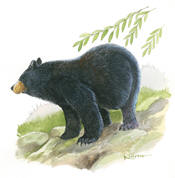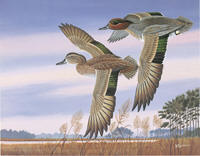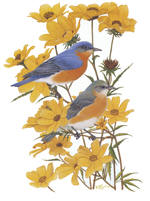|
Natural Artist
by Bill Sherrod, Editor
|

When Carl "Spike" Knuth received
this beautifully illustrated bird book at the age of 6, it ignited
the passion of a natural artist.
|
If you�ve had even a passing interest in homegrown
wildlife art the past 35-plus years, you likely know the name Spike
Knuth.
Carl �Spike� Knuth has become the dean of wildlife
artists in the Old Dominion. Since joining the state game commission (now
the Virginia Department of Game and Inland Fisheries) in 1974, Knuth�s
artwork has adorned everything from Virginia Wildlife magazine covers to
state duck stamps to license plates.
And Knuth, whose Feathered Friends column has been
featured in Cooperative Living since 2005, has a life story nearly as
colorful as the brilliant watercolor illustrations he creates for his
columns.
A Wisconsin Native Who Migrated South
Born in Milwaukee, Knuth grew up around the wildlife-rich
lakes and marshes of southeastern Wisconsin. His nickname, �Spike,� was
coined by his father, who saw the infant Carl flash a crooked smile and
decided the grin was rather gangster-like. �Spike� was a popular gangster
name at the time.�My dad was a technical writer, industrial designer, had
six patents with Mercury Outboards, and did the work of a patent attorney
(without letters) for Mercury Outboards and Kiekhaefer Aeromarine Motors for
nearly 40 years. He was also a motorcycle enthusiast who briefly sold
Harley-Davidson bikes,� says Knuth.
 |
�I was 13 before my dad got his
first car,� he recalls.
�In 1948, our family rode 1,500 miles in three
days, and my baby sister came home from the hospital in 1951 on a Harley.�
The family motorcycle actually accommodated four people: two on the bike
seat, two in the specially made side car.
Perhaps all that fresh air rushing through his hair
predisposed young Spike to a love of the outdoors. When his parents gave him
his first book on birds at age 6, the course was set.
�The outdoors always fascinated me,� Knuth says. �Fishing
and bird-watching, and then later, hunting, were my favorite things to do. I
couldn�t imagine doing anything else for a living.�
Shortly after finishing high school, Knuth went to work
for Mercury Outboard Motors in Wisconsin. For 11� of the 13 years he worked
there, he worked as a commercial artist, doing everything from photo
retouching to signs and truck and boat lettering. In 1969, he took a job as
a photographer at a local newspaper.
�I didn�t have any experience at that, but I was
interested in photography,� says Knuth. �And while I was there, they started
a television station and wanted to air an outdoor show. They asked me if I
would do it, and I said yes.�
Knuth worked a little more than four years at the
newspaper job, then freelanced a while � long enough to realize that
freelance writing is a hard way to make a living.
�In December 1973, I got an interview for a job opening
at the Virginia Commission of Game and Inland Fisheries,� says Knuth. �I
went down to Richmond for the interview, and got the job. I started work
there on Feb. 1, 1974.�
 |
When he began work at what was then known as the game
commission, Knuth was audio-visual supervisor in charge of film, projectors,
and other AV-display equipment.
He ultimately became an information officer and did more
and more artwork for Virginia Wildlife, as well as some writing and
photography, co-hosted and produced a TV program, edited hunting and fishing
guides, did the weekly Outdoor Report, did some short radio spots on WRVA
for seven years, and supervised the Information Office.
�I
was like a kid in a candy store with wildlife-art ideas � center-spreads
with turtles and frogs, birds, fish, all sorts of things.�
That variety of topics and subjects continued to evolve
for more than 29 years until Knuth retired in June 2003. During that time
he�d refined his writing and art techniques through his work for the
Department of Game and Inland Fisheries, art shows and contests, and other
outlets.
A Lifelong dedication
�I consider myself a naturalist. I try to keep notes on
all of my outdoor observations,� says Knuth. His home office is filled with
outdoor journals dating back to his youth.
During high school, he took some art classes, but Knuth
says he began painting in earnest in 1963, the year he and his wife, Susie,
married. �Susie bought me a watercolor set. I started painting on an old
porcelain table, in the musty basement of the duplex where we lived at that
time.�
Nearly 50 years and more than 3,000 paintings and
illustrations later, Knuth continues his chronicling of nature in words and
images. Although now retired, he still contributes to outdoor publications
such as Virginia Wildlife and Chesa�peake Style. His words and images grace
the ever-popular Virginia Wildlife Calendar, and each year he participates
in art shows in White Stone and Chincoteague Island on the Eastern Shore. He
has donated more than 480 original paintings to Ducks Unlimited since 1967,
and in 2005 DU awarded Knuth the Golden Teal Award for his contributions to
the organization�s work toward preservation of waterfowl and waterfowl
habitat.
 |
�I don�t call myself an artist � I�m an illustrator,� he
says. But many people familiar with his work would disagree and insist that
Knuth is indeed an artist. He has won numerous awards for his artwork from
organizations such as the Outdoor Writers Association of America and the
Virginia Outdoor Writers Association. His favorite painting,
�Yellowthroats,� made it into the Leigh Woodson Yawkey Art Museum display, a
juried art show, where it was selected for a worldwide tour of art, and
eventually was chosen as the cover art for an issue of the magazine
Edinburgh Today, a Scottish publication.
How does Knuth capture the muse when he sets about
creating his imagery? �I have notes and photos on many different ideas. I
have a notebook with entries of things that I want to paint. For example, at
some point in the past, I might have seen a big rock with grasses draped
over it at the shoreline of a pond, and made a mental note, then a written
note, that this would be the ideal setting for a northern water thrush.
Sometimes, I�ll photograph the actual setting for future reference,� he
adds.
�If someone gives me an assignment, I�ll do the research
to fit the assignment,� Knuth continues. �My goal the last 12 years has been
to learn as much as I could about flora (vegetation), reptiles, amphibians,
fish, and mammals,� he adds. �I wanted the work to be as authentic as
possible.� He says his wife, Susie, and their sons, Barry and Matt, all have
artistic talents, and his brother, �Rocky,� and Rocky�s son, Joshua, both of
Oshkosh, Wis., are also accomplished artists.
While he�s slowed down some in retirement, Knuth today is
the same eager student of nature as when he received that first of many bird
books from his parents back when he was only 6 years old. His love of nature
and the sheer joy of being outdoors are what keep him going.
 |
�Sometimes, I like to go out and just sit in one place
for a long time. The birds and all of nature just forget you�re there, and
they�ll come right up to you,� he notes.
�I�ve been drawing or painting birds since I was probably
6 or 7, but art was never my main interest. It�s just been a way I could
share my love of wildlife,� he concludes.
Interested? Spike Knuth�s artwork can be seen at
Windemere Art Gallery in Mechanics�ville, Va. (6162 Mechanicsville Turnpike;
804-730-0384) and Turner Sculpture and Art Gallery in Onley, Va. (27316
Lankford Hwy; 757-787-2818). Upcoming art shows include: Rappahannock River
Wildlife Art Show, March 17-18, 2012, at the White Stone Volunteer Fire
Department in White Stone, Va. (804-435-6355); and the Chincoteague Island
Easter Decoy and Wildlife Art Show at Chincoteague High School, April 6-7,
2012 (for more info, call the Eastern Shore of Virginia Chamber of Commerce
at 757-787-2460). Original artwork from his existing catalog, as well as
commissioned pieces, may be purchased directly from Knuth at very reasonable
rates. Email inquiries to the artist at [email protected]. For
more information, visit his website at:
www.knuthwildlifeart.com.
|
|